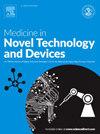Estimating pulmonary arterial pressure from 4D flow images
Q3 Medicine
引用次数: 0
Abstract
The non-invasive method for estimating the pulmonary arterial pressure (PAP) plays an important role in the screening and diagnosis of pulmonary arterial hypertension (PAH). We aimed to establish a phase-contrast magnetic resonance imaging (PC-MRI) based method to estimate PAP. Through analyzing a patient's morphologic and hemodynamic features, this method could be used to identify PAH, and provide diagnostic and grading information for PAH. We selected 39 study participants, comprising 18 healthy volunteers and 21 patients with PAH. Morphologic and hemodynamic parameters of each participant's pulmonary arteries were obtained from 4D Flow images. Hemodynamic features were performed selected by principal component analysis (PCA). PAH identification model was built with binary logistic regression. Furthermore, A multiple linear regression (MLR) model was developed to estimate PAP, the accuracy of which was evaluated by comparing it with the value measured by right heart catheterization (RHC). PAH identification was achieved with high accuracy, using the features of pulmonary arterial morphology or blood flow velocity (BFV). Compared with RHC, MLR results showed that using pulmonary arterial morphology and BFV features in combination can greatly improve the accuracy of PAP estimation. Our results showed that the mean relative error of PAP estimation in PAH patients could reach <10 %. A highly accurate PC-MRI based method for PAH identification and PAP estimation was successfully established. Using hemodynamic features of the pulmonary artery could improve PAP estimation accuracy, which highlights the importance of hemodynamic evaluation of pulmonary arteries in the screening and diagnosis of PAH.
从四维血流图像估计肺动脉压
无创肺动脉压(PAP)评估方法在肺动脉高压(PAH)的筛查和诊断中具有重要作用。我们的目的是建立一种基于相位对比磁共振成像(PC-MRI)的方法来估计PAP。该方法通过分析患者的形态学和血流动力学特征,可用于鉴别PAH,为PAH的诊断和分级提供信息。我们选择了39名研究参与者,包括18名健康志愿者和21名PAH患者。通过4D血流图像获得每位参与者肺动脉的形态学和血流动力学参数。采用主成分分析(PCA)选择血流动力学特征。采用二元logistic回归建立多环芳烃识别模型。此外,建立了多元线性回归(MLR)模型来估计PAP,并通过将其与右心导管(RHC)测量值进行比较来评估PAP的准确性。利用肺动脉形态或血流速度(BFV)的特征,可以获得高精度的PAH鉴定。与RHC相比,MLR结果表明,结合肺动脉形态学和BFV特征可以大大提高PAP估计的准确性。我们的结果显示,PAH患者PAP估计的平均相对误差可达10%。成功建立了一种基于PC-MRI的高精度多环芳烃识别和PAP估计方法。利用肺动脉血流动力学特征可以提高PAP估计的准确性,这凸显了肺动脉血流动力学评价在PAH筛查和诊断中的重要性。
本文章由计算机程序翻译,如有差异,请以英文原文为准。
求助全文
约1分钟内获得全文
求助全文
来源期刊

Medicine in Novel Technology and Devices
Medicine-Medicine (miscellaneous)
CiteScore
3.00
自引率
0.00%
发文量
74
审稿时长
64 days
 求助内容:
求助内容: 应助结果提醒方式:
应助结果提醒方式:


